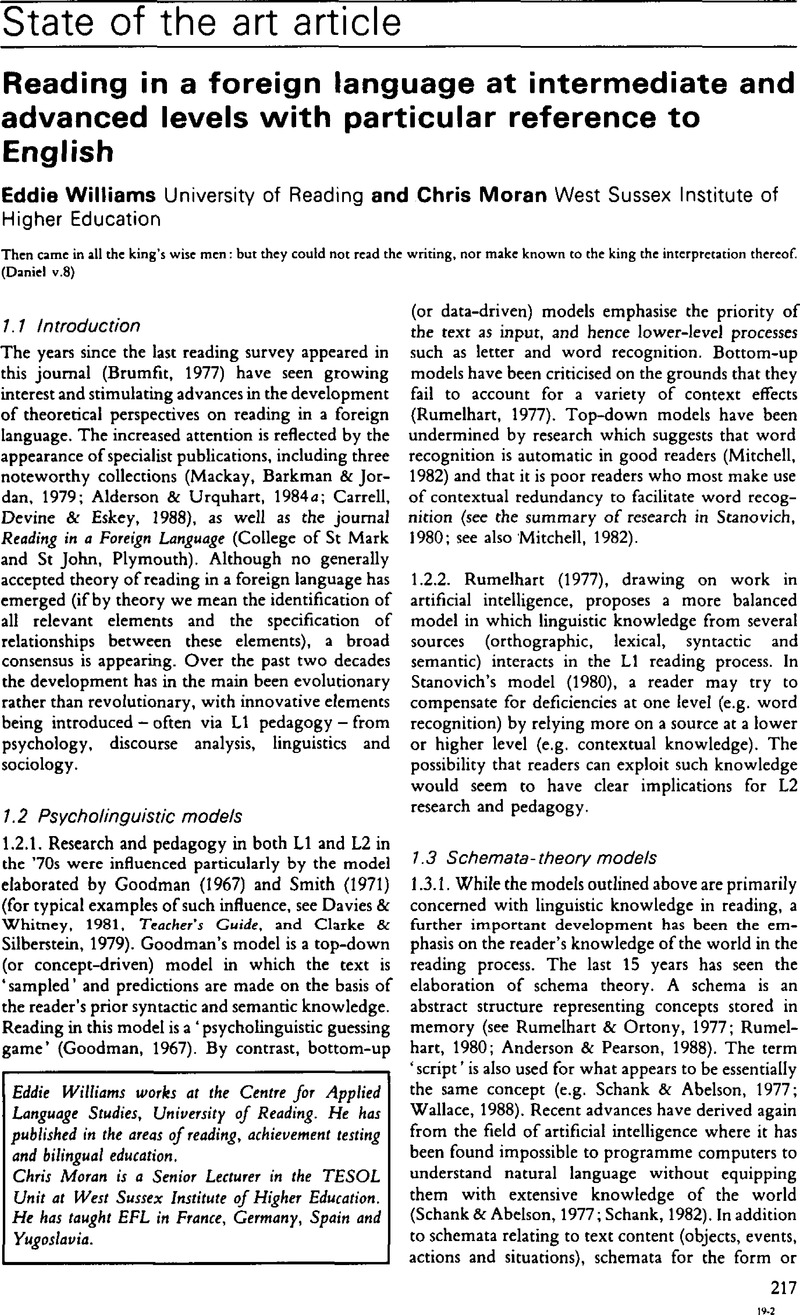Crossref Citations
This article has been cited by the following publications. This list is generated based on data provided by Crossref.
BOWLING, CAROL
and
MITCHELL, ANITA
1993.
Reading in a Specific Purpose Foreign Language Course: A Case Study of Technical Japanese.
The Modern Language Journal,
Vol. 77,
Issue. 4,
p.
433.
HULSTIJN, JAN H.
1993.
When Do Foreign‐Language Readers Look Up the Meaning of Unfamiliar Words? The Influence of Task and Learner Variables.
The Modern Language Journal,
Vol. 77,
Issue. 2,
p.
139.
McQueen, Joy
1996.
Rasch scaling.
Australian Review of Applied Linguistics. Series S,
Vol. 13,
Issue. ,
p.
137.
Carrell, Patricia L.
and
Carson, Joan G.
1997.
Extensive and intensive reading in an EAP setting.
English for Specific Purposes,
Vol. 16,
Issue. 1,
p.
47.
Weir, C. J.
1997.
Encyclopedia of Language and Education.
p.
39.
Bamford, Julian
and
Day, Richard R.
1998.
Teaching Reading.
Annual Review of Applied Linguistics,
Vol. 18,
Issue. ,
p.
124.
Cohen, Andrew D.
and
Upton, Thomas A.
2006.
STRATEGIES IN RESPONDING TO THE NEW TOEFL READING TASKS.
ETS Research Report Series,
Vol. 2006,
Issue. 1,
Cohen, Andrew D.
and
Upton, Thomas A.
2007.
`I want to go back to the text': Response strategies on the reading subtest of the new TOEFL®.
Language Testing,
Vol. 24,
Issue. 2,
p.
209.
Mebarki, Zahia
2011.
Factors Underlying the Reading Performance of Algerian Microbiology Students.
Procedia - Social and Behavioral Sciences,
Vol. 29,
Issue. ,
p.
1759.
Alavi, Sayyed Mohammad
and
Bordbar, Soodeh
2012.
A Closer Look at Reading Strategy Use in Reading Section of TOEFL iBT.
Theory and Practice in Language Studies,
Vol. 2,
Issue. 3,
Freahat, Nasser M.
and
Smadi, Oqlah M.
2014.
Lower-order and Higher-order Reading Questions in Secondary and University Level EFL Textbooks in Jordan.
Theory and Practice in Language Studies,
Vol. 4,
Issue. 9,
De Leon, John Angelo Vinuya
and
Tarrayo, Veronico Nogales
2014.
�Cyber� Reading in L2: Online Reading Strategies of Students in a Philippine Public High School.
i-manager’s Journal on English Language Teaching,
Vol. 4,
Issue. 2,
p.
8.
Larijani, Laya
Kasmani, Morad Bagherzadeh
and
Sabouri, Narjes Banou
2015.
Exploring the Effects of First Language Reading on Second Language Reading across Different Proficiency Levels.
Theory and Practice in Language Studies,
Vol. 5,
Issue. 3,
p.
646.
Montero-Arévalo, Sindy Johana
2019.
Effects Of Genre Based Approach (GBA) In EFL Reading Comprehension And Writing.
GIST – Education and Learning Research Journal,
p.
84.
Ewert, Doreen E.
2019.
The Handbook of Informal Language Learning.
p.
395.
Kong, Jufang
2019.
Investigating the Role of Test Methods in Testing Reading Comprehension.
p.
9.
Villanueva, Ana
Liu, Ziyi
Kitaguchi, Yoshimasa
Zhu, Zhengzhe
Peppler, Kylie
Redick, Thomas
and
Ramani, Karthik
2021.
Towards modeling of human skilling for electrical circuitry using augmented reality applications.
International Journal of Educational Technology in Higher Education,
Vol. 18,
Issue. 1,
Ipsita, Ananya
Erickson, Levi
Dong, Yangzi
Huang, Joey
Bushinski, Alexa K
Saradhi, Sraven
Villanueva, Ana M
Peppler, Kylie A
Redick, Thomas S
and
Ramani, Karthik
2022.
Towards Modeling of Virtual Reality Welding Simulators to Promote Accessible and Scalable Training.
p.
1.
Robles, Heydy
Jimeno, Miguel
Villalba, Karen
Mardini, Ivan
Viloria-Nuñez, César
and
Florian, Wendy
2023.
Design of a micro-learning framework and mobile application using design-based research.
PeerJ Computer Science,
Vol. 9,
Issue. ,
p.
e1223.





